Six-channel sound, built-in FM tuner and media player
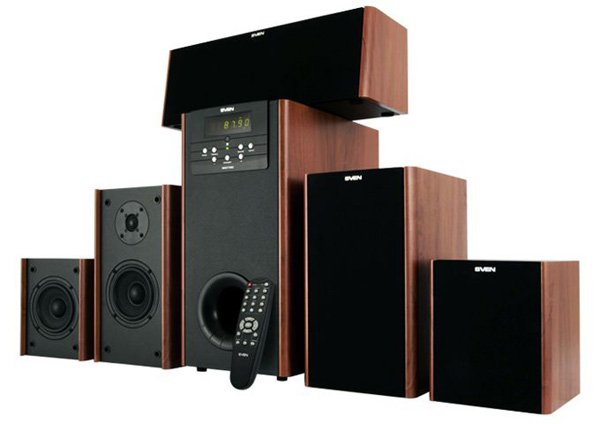
5.1 speaker system SVEN IHOO T100U for home theatre |
In the recently published parallel testing of 5.1 speaker systems, where Genius SW-HF5.1 6000 and SVEN IHOO T100U, were tested, it turned out that the SVEN model was better than its contender was. SVEN IHOO T100U was more interesting just as in sounding quality, so in being equipped (in particular, it has a built-in FM tuner and media player), therefore we, as we have promised, will review it more fully. Of course, at that we were not able to avoid some repetitions, for what we make our apologies to readers of the previous material.
T100U is supplied in two color versions – black and MDF. But it concerns side panels only, and front, upper and, of course, back surfaces are black, with light shagreen.
Package and contents
The speaker system is supplied in an ordinary carton with monochrome (black) color, where short specifications and information about the content are available in multi-languages. The gross weight is more than 22 kg, so hand slots in the carton side panels help very much during transportation.
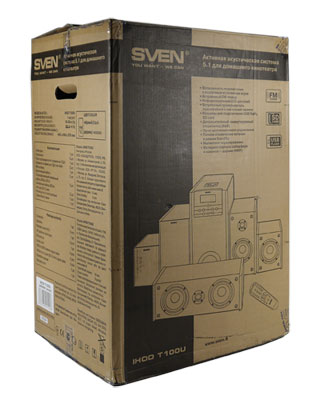
Carton with SVEN IHOO T100U |
-
There are the following items in the carton besides the subwoofer and satellites:
- Operation Manual,
- Warranty card,
- Remote control with batteries,
- FM antenna,
- cables with soft silicon cover to connect passive speakers (thickness 0.2 mm²/24AWG according to designation, length: two cables 8 m long and three cables 2.5 m long),
- three 2 × RCA–2×RCA cables 1.5 m long,
- three 2 × RCA–mini-jack cables 1.5 m long.

Set from the carton |
Subwoofer and control panel
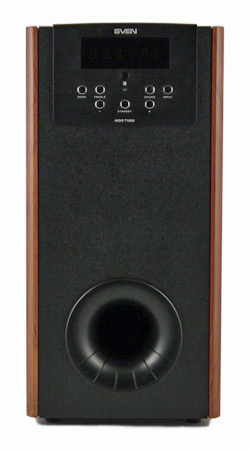
Subwoofer front panel |
Let us start from the subwoofer. There is a wide bell mouth of phase inverter output port in the lower part of its front panel, and the upper part is occupied with the control panel with the information board assembled with six seven-segment green LED indicators. Symbols on indicators are quite big, but their brightness is not too intensive to keep the readability during bright light and not to irritate in an obscure room – rather the bright green LED on/off indicator will irritate, located a little bit lower, which illuminates even in the Standby mode. Different presets, FM tuner settings or a number/time of a sound track are displayed depending on an operation mode. However, we have not found a mode, when the leftmost seven-segment indicator starts illuminating. There are illuminated inscriptions in the upper and lower parts of the information board, which display a selected input, sound mode, etc.

|

Information board |
There are seven buttons on the panel to control modes, which enable to turn on/off the Standby mode, select an input, control master volume and LF/HF timbre. Other functions including the tuner setting and selection of stations are entrusted to the remote control, the sensor of which is located between the indicator and buttons. The buttons on the control panel are not very easy-to-use: they are hard, some time quick strokes are not worked off.

Subwoofer control panel |
Presets, including the selected input, are saved after switching to the Standby mode and the next exit (when the speaker system is turned off with a mechanical switch, the tuner presets are saved only).
There is the panel of a media player on the upper plane of the subwoofer – a slot for SD cards, USB port, player activity indicator and three control buttons: shift to the next or previous track, as well as pause/playback.
Acoustic appearance is executed interestingly: this is the 4th order bandpass, but not “canonical”, when the phase inverter protrudes from the chamber of less volume, in which the loudspeaker front side is directed (such design we saw in Microlab M-290 and Corsair SP2500, see left fig.), but a somewhat different. In the first place, the back chamber, where the loudspeaker rear part protrudes to, is less by volume than the front chamber. In the second place, the loudspeaker inside the subwoofer case is turned “heading backward” and in order that the phase inverter pipe protrudes to the front panel, it was laid through the rear chamber (see right figure).
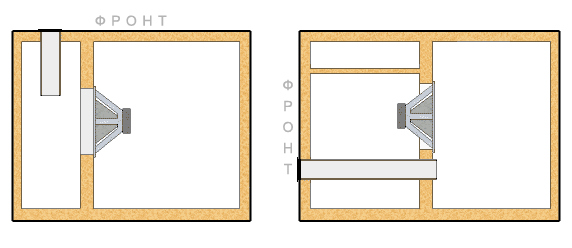
|
Obviously, such configuration is explained above all by a selected design – the case elongated vertically, as well as the necessity to protrude the phase inverter port to the front panel to avoid problems when choosing a place to locate the subwoofer. At that, the phase inverter pipe must have a calculated length and it cannot be very short, that determined the loudspeaker orientation.
Let us remember: the contraction of the bandpass back chamber volume leads to the increase of coefficient of efficiency, and this is very good and even admirably. However, at that, borders of the working frequency bandwidth are shifted upwards, and that is worse for the subwoofer, but the bandwidth narrows, which does not cheer, because it is a direct way to hum-type and muttering sound. Therefore, they try not to make the rear chamber too small.
In this case, its volume decreases due to the control and commutation unit, as well as the media player, which are located in the front part of the case and separated from the rear bandpass chamber with a MDF partition (it is also shown in fig.). The partition – it is very good, of course, but the chamber volume due to this is turned out approximately by a fourth less, and besides an appreciable part is taken away by the phase inverter pipe, which passes through the rear chamber.

Interior of IHOO T100U |
The front chamber has an influence mainly on the form of the gain frequency characteristic: contraction of its volume reduces the amplification as well, but it makes the characteristic top more flatter, i.e. it levels the resonant character of the bandpass, but to some limit as well. And, of course, a great deal depends on the geometry of the phase inverter pipe
By this means, the bandpass is a very capricious thing, and during its designing it is necessary to observe precisely the balance of pluses and minuses. For this purpose not only a meticulous calculation and qualitative manufacturing are required, but on frequent occasions and fine adjustment of the subwoofer taking into account individual features of a certain loudspeaker, that is impossible in the extensive manufacturing. However, the full-scale production – it is also a prime cost, therefore there are electronic boards with a lot of connecting cables in chambers for all bandpasses considered by us, it is very difficult to take into account the influence of them on sound reproduction during calculations.
We are finishing theorizing and let us looking at the gain frequency characteristic of T100U subwoofer:

GFC of IHOO T100U subwoofer |
Yes, the amplification is rather big, but in the very narrow range, what is more, it is related to not the lowermost frequencies. It is the cost of small volume of the rear chamber, and that is why GFC has not acute, but appreciably more flatter top.
Then why are bandpasses used in general? The point is that shortcomings become apparent mainly during listening to the music, moreover during serious listening, but not in the background. If we speak about the music for a merry evening-party or about sounding films and games, then the loud bass goes out on the first plan, and the bandpass provides it better, than other variants of acoustic environment (all other things being equal, of course).
But let us go back to description to the subwoofer construction. It has the MDF case 12 mm thick and there are no any sound absorbing materials in it at all. A sealing gasket is not available as well in the place of joint of the rear wall and the plate with an amplifier and connectors. Legs 12 mm high are made of rather soft rubber with good shock absorbing ability.
The loudspeaker with the cone 14.5 cm in diameter, with 50 W and 6 Ohm is mounted in the subwoofer. Places of the loudspeaker mounting and connecting cables are furnished with sealants.
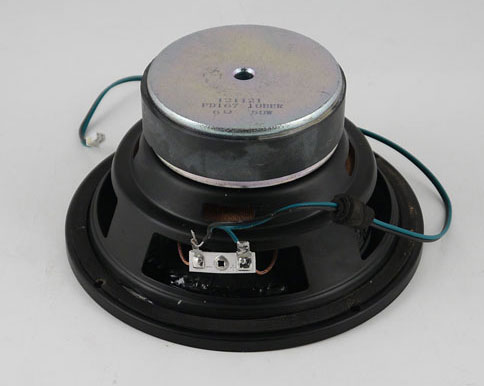
Loudspeaker of IHOO T100U subwoofer |
The length of the phase inverter pipe is equal to 15.3 cm, diameter of its middle part is 50 mm, external and internal ends are bell-shaped and the protective net is stuck to internal end from the inside.
Amplifier
Practically the whole electronic part is concentrated on one board fixed on a metal plate, which closes a notch in the rear wall of the subwoofer. A power source, the board of which is fixed on the case bottom, as well as the media player and indication and control unit in the front part of the subwoofer are located separately.
Input (RCA) and output (spring-loaded clamps) connectors, antenna input of the tuner and mechanical power switch are located on the same plate. The places of their location, as well as the opening for the power cable are sealed.
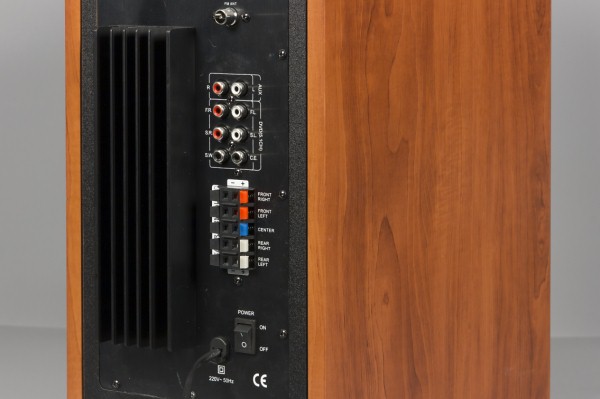
Rear panel of IHOO T100U subwoofer |
SJ2323 microcircuit, which has one six-channel and four two-channel inputs, is responsible for the commutation. The same microcircuit emulates six-channel sound for stereo signals.
The volume control is assembled on the PT2258 six-channel microcircuit. Other regulations (amplification per channels, LF/FH timbre) are carried out by the SC7313 microcircuit, it controls the Mute mode as well.
The tuner is assembled on the RDA5807SP microcircuit.
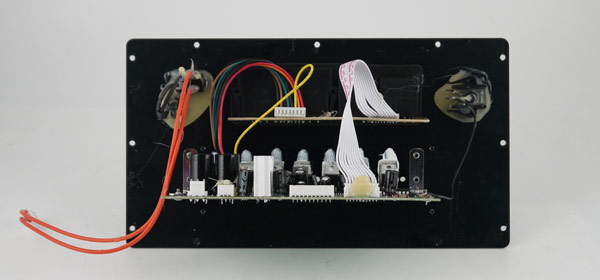
|
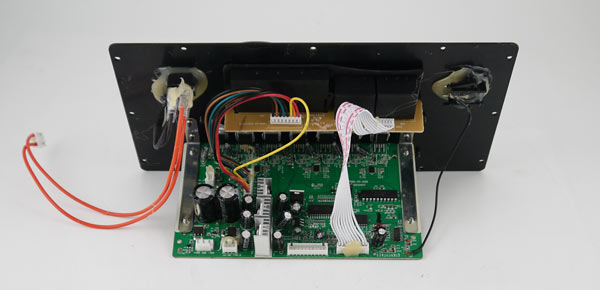
Boards of IHOO T100U subwoofer |
Power amplifiers for satellites are assembled on TDA 2030L integral low-frequency amplifiers – one per channel. Two more powerful TDA2050 microcircuits, which are connected according to the bridge circuit, are used for the subwoofer.
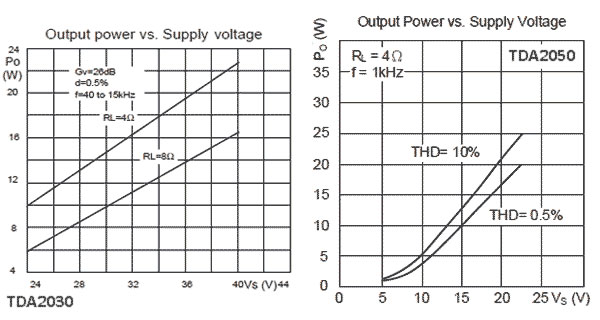
Diagrams |
Unfortunately, we were not able to find the output power- voltage diagram for TDA2050 with the bridge circuit; therefore, the given diagram corresponds to the standard connection.
The general radiator with vertical ribs protruded outside is used for all power amplifiers. In the absence of a signal the radiator is heated only for 7-8°C higher than room temperature, however during sound reproduction with increased volume over a long period of time, the heating will be much more substantial, and while choosing a place for the subwoofer it is necessary to provide normal air circulation near its rear panel.
The power unit is assembled as per the circuit with frequency transformation and provides ±14 V voltage (in stand-by mode) for the low-frequency amplifier. Wires from the low-frequency amplifier are equipped with a ferrite ring to reduce interferences. The power supply filter on the board of amplifiers is assembled on two condensers 4700 µF each. Voltages required for other microcircuits are generated based on the voltage from the power unit by separate automatic voltage regulators located also on the amplifying board. There are no renewable fuses.
Media player
The media player reproduces MP3 files from SD cards and USB flash carriers. Its operation logic is quite clear: when a SD card or USB flash carrier is inserted, playback of musical files starts automatically both from a root directory and from available folders (even with high nesting level), and the front indicator displays the track starting time and a carrier type, "USB" or "SD". If a carrier of a certain type is inserting in the player, when there is a carrier of another type there, then playback from it is halted and files from the newly inserted carrier will start playing. To start playback files from the previous carrier press the input selection button "Input", at that the playing will start from the place, where it was stopped after inserting the second carrier. The same takes place as well when switching to DVD input or AUX and the next return to SD card or USB flash carrier, as well as during entering in Standby mode or exit from it.
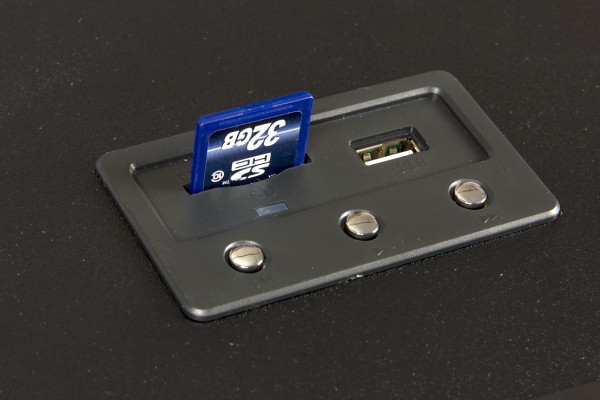
Connection of USB flash carrier |
When any of the previous or next track buttons is pressed, the front indicator displays a track number for the pair of seconds, and then it starts to display the playtime of a fragment. These buttons enable not only to select tracks, but if to press and hold pressed one of them, to carry out also "scrolling" within the track limits. A green LED indicator on the panel of the media player blinks during the playback, it illuminates constantly in the pause mode and goes out, if no carriers are inserted or another input is selected – DVD, AUX or FM.
The media player can be controlled both from its own panel on the upper cover of the subwoofer and from the remote control.
FM tuner
Claims are not available at all to the radio tuner sensitiveness: in a building with reinforced concrete walls and ceiling, the tuner has received 21 radio stations with admissible quality on a primitive aerial from the package content, being a piece of wire with a connector on one end and a fixation eyelet on the other end.
Control of the tuner is simple, but it can be controlled from the remote control only. After pressing the "Tun+" button within 1.5 seconds, we initiate the automatic scan of radio stations, which are stored in the memory with thirty cells. In future you may select any station by pressing the "CH" button (the indicator will display "CH" and channel number), or you may select a desired channel by pressing the "Tun+" and "Tun -" buttons. Of course, there is also the manual mode of radio station scanning with a possibility to store them in the memory.
When the power is turned off, the stored stations are saved; you can empty the memory with the "Preset" button on the remote control.
Satellites
Side panels of central, front and rear speakers are protruding relative to the front wall and have the chamfered front edge, which visually forms transition to the removable non-dense fabric grill on a plastic frame. The front part of central speaker is chamfered and its loudspeakers are directed slightly upward; it will be useful while placing this speaker lower than a listener’s head, but if it is placed on any eminence (for example, on a shelf) it will be rather a disadvantage.
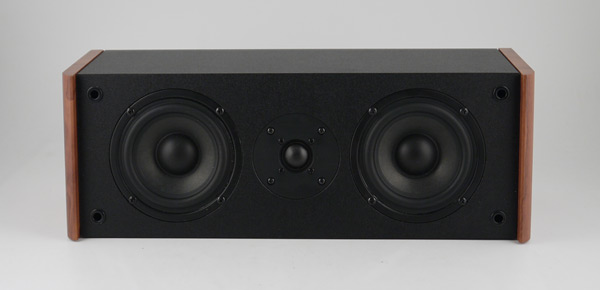
Front panel of central speaker |
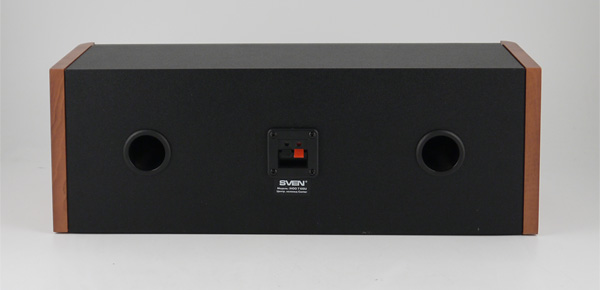
Rear panel of central speaker |
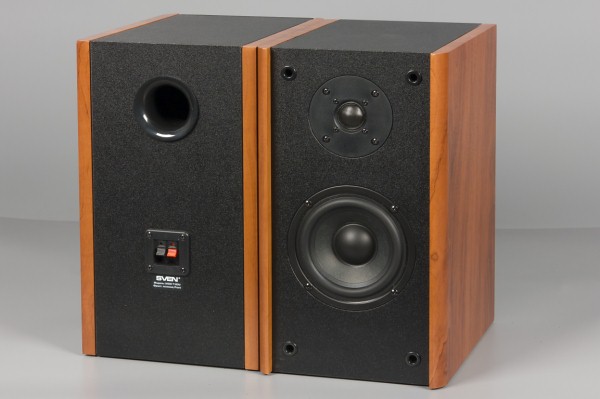
Front and rear panels of front speaker |
All satellites have MDF cases 9 mm thick, there are no sound absorbing materials inside them, as well as in the subwoofer. Acoustic appearance is a phase inverter, ports (the central speaker has two ports, other speakers have one) are located on the rear wall, that is why the speaker system must not be placed close to the wall. Pipes of phase inverters of all satellites have cylindrical shape. The pipe of the central and rear speakers is 30 mm in diameter and 7 cm long, of the front speaker – 39 mm and 4.8 cm accordingly.
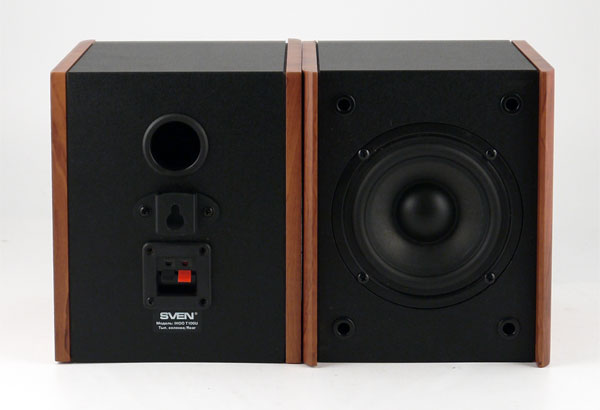
Front and rear panels of rear speaker |
Only the central and front satellites have small legs in the form of porous rubber round stickers 2 mm thick, the rear speakers have metal suspension for mounting on the wall. But hanging the rear speakers to the wall with the help of self-tapping screws will not be the best solution: all speakers, except the subwoofer, must be orientated in a certain way relative to a listener (it is not necessary to find a mounting diagram, it is available in the Operation Manual), but a proprietor must think how to realize it with the help of available simplest suspension. It should be noted to justice’s sake that this applies not to SVEN IHOO T100U only. However the rear speakers of the model do not have legs, i.e. the producer did not envisage the variant of their placement on a shelf, but when they are wall-mounted on the vertical surface, the gap between it and the phase inverter output will be 5 mm only.
LF/HF loudspeakers with a diffuser 9 cm in diameter, 15 W capacity and 4 Ohm impedance are used in side satellites, the central speaker has two such in-parallel loudspeakers, but their impedance is 8 Ohm. The central and front speakers have one tweeter each with silk dome (diameter 2.5 cm, capacity 15 W, impedance 4 Ohm; a 3.3 µF condenser is used as a filter), the rear speakers do not have HF loudspeakers. Loudspeakers are fastened in milled slots, therefore their cases are not protruded from the front panel; fixation places of loudspeakers are not sealed.
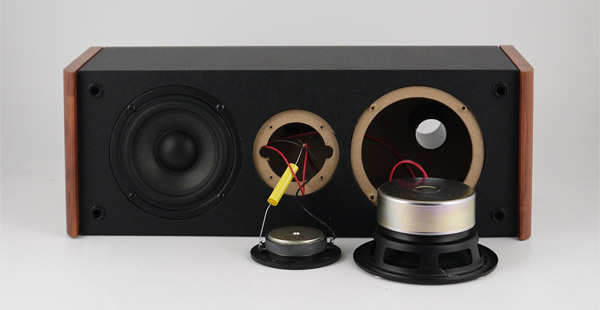
|
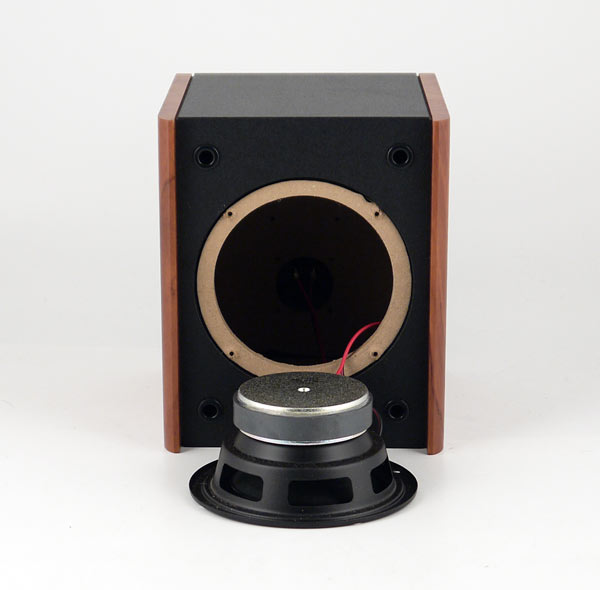
|
The same spring-load clamps, as in the subwoofer, are used in satellites to connect them to amplifiers. Opening for plastic panels with clamps are not sealed as well.
Below we provide gain frequency characteristics of satellites (from top to bottom: center, front, rear). According to the diagrams, it is impossible to say that two LF/MF loudspeakers of the central speaker positively affected the playback of lower frequencies in comparison with the front speakers; however, the marked expressed sound orientation of the central speaker is noticeably less. But on the other hand, it is quite clear that the absence of tweeters in rear speakers narrowed greatly the range reproduced by them in the high frequency area, and their less volume – also on LF as well.
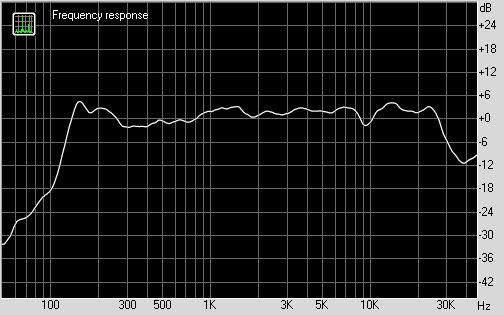
GFC of central channel |

GFC of front channels |
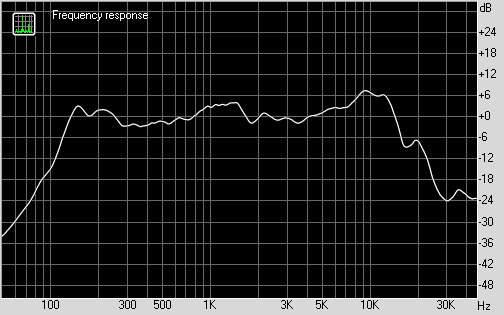
GFC of rear channels |
Remote control
The remote control is quite rounded, but due its oval shape it comfortably lies in the hand. Its buttons are grouped quite logically, you do not need to get used to their location for a long time, and their stroke is soft and clear. The remote control buttons carry out the complete set of regulations, presets and commutations envisaged by the model electronics, including also those, which are not accessible from the subwoofer control panel: the tuner settings, radio station selection and reset. And, of course, it is possible to control functions of the media player.
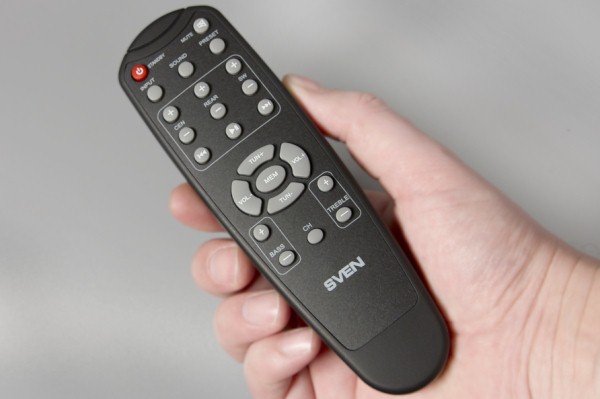
Remote control |
We have no complaint to the sensor sensitiveness: you may practically not to think about the remote control orientation relative to the sensor in the subwooferе.
The remote control is powered by two ААА alkaline batteries.
Sounding
Let us repeat in short the listening results given in the comparative review.
The use of silk tweeters in the front and central speakers made their sounding in FH field quite full-fledged, but all the same far from the ideal: there are perceptible distortions, which underline the highest frequencies. What is more, sounding of front speakers has strongly pronounced orientation: the sound timbre changes greatly at deviation from the optimal point of listening vertically.
With middle frequencies, sounding of speakers is quite good as a whole and it is deprived of obvious defects. You can only to complain that LF/MF loudspeakers are used with the cone 9 centimeters in diameter only, while the case dimensions enable to install bigger loudspeakers, which would change sounding in lowercase to the best.
The bandpass resonant diagram used in the subwoofer is at a disadvantage regarding legibility in LF range to diagrams with the cone located outside. During listening to music, it is an appreciable shortcoming: the subwoofer sounding is illegible and has hum-like character. As satellites are not able to sound a register below 100 Hz, and a strongly limited operation range of the subwoofer is in 50 Hz area, then there is some failure between these frequencies. However, when playing tracks to movies or sound accompaniment of games, deep and equalizered bass of SVEN IHOO T100U sounds quite effectively. Moreover, the subwoofer is not localized in space and that is a positive moment.
Conclusions
Of course, the main thing in any speaker system is its sounding, and we think that the sounding of SVEN IHOO T100U is quite good as a whole. However, possibilities of satellites, especially of the rear satellites, are far from what we see in modern models of active stereo speakers. The subwoofer leaves double impression: its powerful bass suits quite well to sound movies and games, but for the serious listening of music it is suitable a little.
Other features were listed at the parallel testing, let us to repeat them here once again, but now irrespective of any other model.
-
Advantages:
- background and noise levels: low, practically do not depend on the volume level;
- easy-to-use remote control with good sensor sensitiveness.
-
Disadvantages:
- absence of HF loudspeakers in rear speakers;
- clicking sounds during regulations (though they are audible at high volume level only).
-
Doubtful solutions:
- standard suspension of rear speakers leaves a very small gap between the phase inverter output and the wall, besides it creates additional problems for the orientation of these speakers relative to a listener;
- no possibility to connect headphones;
- several settings and presets, as well as the tuner and Mute mode can be controlled from the remote control only.
The availability of LF/HF timbre control and Standby mode control we consider normal for active speakers of such price category and the utility of FM tuner and media player available in T100U every reader will estimate in accordance with his tastes.
There is another moment, which was not so important 6-7 years ago, but quite urgent today – the absence of digital inputs. The less of playback appliances are equipped with analog outputs, especially multichannel, which either limits the application field of 5.1 speaker systems, similar to T100U, substantially or requires additional expenses for a decoder from the proprietor. SVEN Company has in its product line 5.1 HT-435D speaker system equipped with both digital inputs and built-in DD5.1/DTS decoder, at that its price is quite affordable; therefore, we can only regret that T100U does not have them. We hope that a similar model will appear in the IHOO series.
